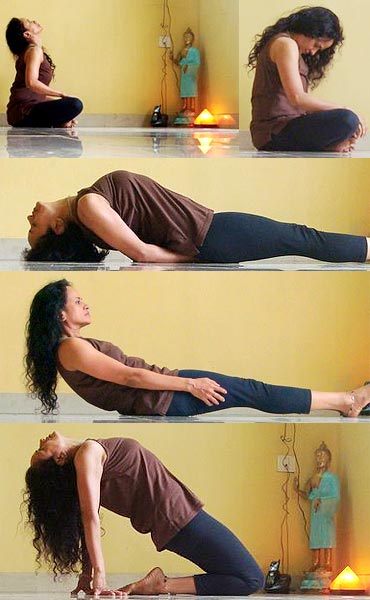
Though double chin is usually the bane of overweight people, thin people are also known to get it. In the latter case, genetics is partly to blame. But blame also has to be directed at bad posture and a lethargic lifestyle.
Ungainly fat deposits are usually due to bad eating habits that mess up how the body treats its stored fat. This may also explain why thin people who are not physically active display love handles or wobbly chins or loose, flabby upper arms. These are also signs of loss of muscle tone, reduction in supportive tissue like collagen (that requires a healthy diet to keep you looking young), improper lymphatic drainage and a choked circulatory system.
In yoga, the poses for attacking the flab at the chin also massage the thyroid which is linked to your metabolic rate. Right behind the thyroid are the parathyroid glands also linked to tissue health. So apart from the obvious muscular tone these practices provide, they also have a subtle but definite impact on how well your body utilizes its stored fat.
However, all yogic practices invariably use the neck as a major pressure point, as in the Surya Namaskar (sun salutes) where the neck is moved in both directions throughout the sequence. Having a regular yoga regimen which challenges you is a sure-fire way to tone up, not just that chin but your entire face and body.
Initially you need to start with just a few rounds or hold the pose for less time. Increase rounds and duration as your practice becomes steady. Those with hyperthyroidism need to exercise caution, and get a go-ahead from their medical consultant before practicing these poses as they stimulate the thyroid.
Beginners may also feel a slight dizziness initially. This is particularly true for those who have not exercised before, or have low blood pressure, inner ear problems, neck pain or vertigo. So phase your practice, not reaching too deeply into the pose initially and go into it only as per capacity. Later, as the body gets accustomed to the yoga asanas, you will stop feeling that way.
Here Shameem Akthar, yoga acharya trained with the Sivananda Yoga Vedanta Center, Kerala, shows you five poses that will firm up your jawline.
For more of Shameem's yoga writings visit https://jaisivananda.blogspot.com. Follow Shameem's yoga products on her online shop Yogatique on Rediff Shopping here.
Disclaimer: This column just shares the columnist's passion for yoga which is ideally learned under the guidance of an expert.
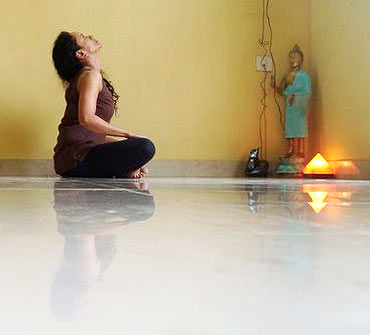
Sit up straight (may be done seated on a chair or standing). Inhale, lifting head up. Exhaling relax it back. Do this five times. This may be done several times during the day, especially if you have a desk-job. Follow it up with gentle neck rolls, circling the head clockwise and anti-clockwise thrice.
All neck movements must be slow and precise. Synchronising it with your breath so each movement follows inhaling or exhaling helps maintain a slow pace which is most effective.
Benefits: Tones the neck muscles. Hikes metabolism. Stimulates the mind. Is a good warm-up for any fitness programme.
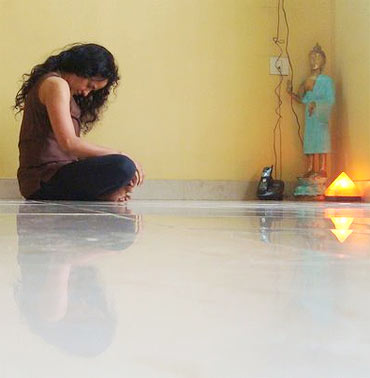
Sit up straight. Inhale. While exhaling bend head so the chin locks between the collarbones. Continue breathing gently, focusing your entire attention on the stretch of muscles along the neck and upper back. Hold for a count of five.
You can later incorporate this as part of your breath retention if you are already practicing Pranayama or yogic breathing practices.
Benefits: Is said to curb wastage of energy from the nervous system; massages the thyroid and parathyroid affecting metabolism and tissue health. Improves focus. Improves breathing by stretching the back muscles involved with respiration.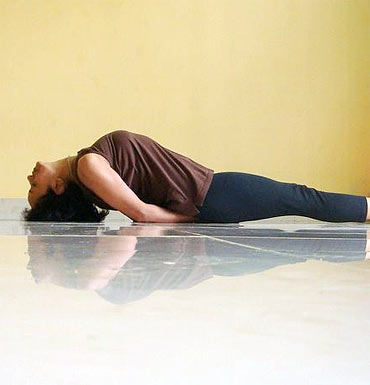
Lie down on your back. Take your arms behind you, ensuring elbows are fully hidden under your back. Bring feet together, so legs are lightly touching. Inhale. Raise your head to look at your toes. Exhaling, drop head back so that crown rests on the floor.
Shift mental focus to elbows and crown, and deepening the upper back arch by tucking in shoulder blades. Ensure mouth is shut. Hold the pose for five breaths. Release. Repeat thrice. After a few weeks, you can do this just once but hold the pose longer, for half a minute or more.
Avoid: If you have vertigo or neck problems.
Benefits: Tones the neck region, firming it. Massages the thyroid and parathyroid. Boosts respiration. Improves immunity by servicing the thymus gland. Keeps the face looking young by stretching it completely.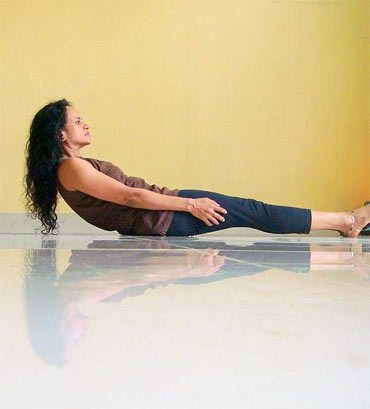
Sit up straight, legs stretched out in front. Hold hands on either side of your body as shown in the picture. Inhale. Exhaling lift legs, keeping them low, closer to ground.
Push the neck back, so that the upper back and neck muscles are challenged. Hold the pose for five breaths, focusing on your feet. Release. Repeat thrice. After a few weeks, do once but for longer.
Benefits: Tones the upper body, including neck and face. Works on the digestive tract, boosting digestion and metabolism. Tones abdomen and legs. Therapeutic in diabetes.

Sit on your heels with your hands behind. Inhale. Lift up the hips high, dropping neck behind simultaneously. Hold the pose. Ensure hips remain up and chest is open. Take five breaths. Release and repeat thrice. Later hold for just once, but for longer.
Avoid: If you have severe vertigo or neck problems.
Benefits: Same as above, but also tones the lower back and hip region also. Therapeutic in asthma and weight loss.